steering TOYOTA LAND CRUISER 2000 Owners Manual
[x] Cancel search | Manufacturer: TOYOTA, Model Year: 2000, Model line: LAND CRUISER, Model: TOYOTA LAND CRUISER 2000Pages: 235, PDF Size: 5.13 MB
Page 3 of 235
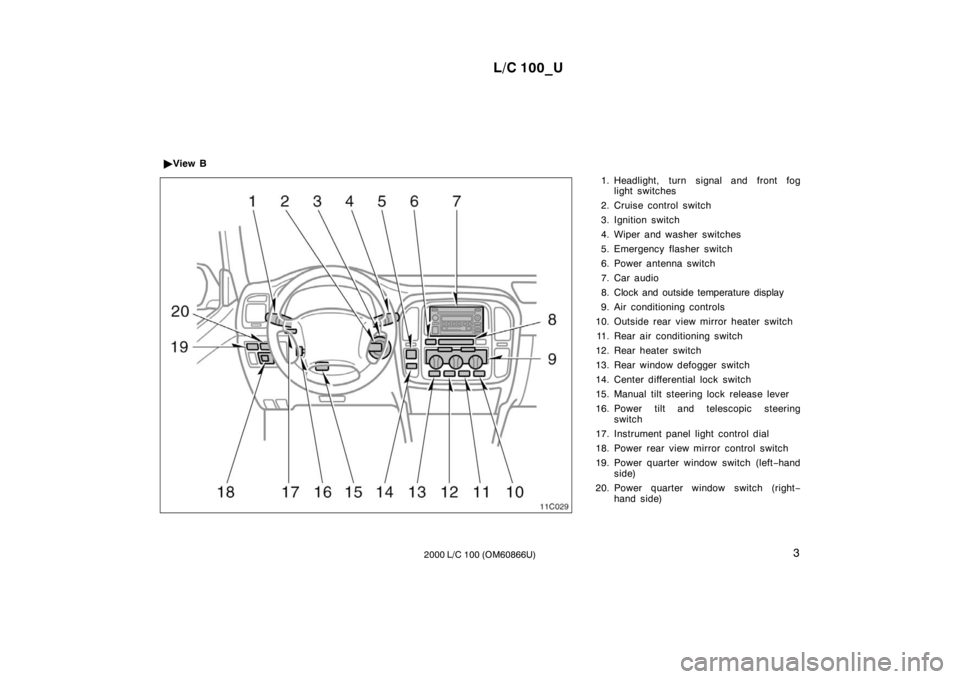
L/C 100_U3
2000 L/C 100 (OM60866U) 1. Headlight, turn signal and front fog
light switches
2. Cruise control switch
3. Ignition switch
4. Wiper and washer switches
5. Emergency flasher switch
6. Power antenna switch
7. Car audio
8. Clock and outside temperature display
9. Air conditioning controls
10. Outside rear view mirror heater switch 11. Rear air conditioning switch
12. Rear heater switch
13. Rear window defogger switch
14. Center differential lock switch
15. Manual tilt steering lock release lever
16. Power tilt and telescopic steering switch
17. Instrument panel light control dial
18. Power rear view mirror control switch
19. Power quarter window switch (left −hand
side)
20. Power quarter window switch (right −
hand side)
�
View B
Page 9 of 235

L/C 100_U31
2000 L/C 100 (OM60866U) OPERATION OF INSTRUMENTS AND
CONTROLS
Seats, Seat belts, Steering wheel and Mirrors
Seats32
. . . . . . . . . . . . . . . . . . . . . . . . . . . . . . . . . . . . . . . . . . . . . . . . . . . . . .
Front seats32
. . . . . . . . . . . . . . . . . . . . . . . . . . . . . . . . . . . . . . . . . . . . . . . . .
Armrests 34
. . . . . . . . . . . . . . . . . . . . . . . . . . . . . . . . . . . . . . . . . . . . . . . . . . . .
Rear seat34
. . . . . . . . . . . . . . . . . . . . . . . . . . . . . . . . . . . . . . . . . . . . . . . . . . .
Head restraints43
. . . . . . . . . . . . . . . . . . . . . . . . . . . . . . . . . . . . . . . . . . . . . .
Seat heaters44
. . . . . . . . . . . . . . . . . . . . . . . . . . . . . . . . . . . . . . . . . . . . . . . .
Seat belts45
. . . . . . . . . . . . . . . . . . . . . . . . . . . . . . . . . . . . . . . . . . . . . . . . . . .
SRS driver and front passenger airbags54
. . . . . . . . . . . . . . . . . . . . . . . .
Child restraint61
. . . . . . . . . . . . . . . . . . . . . . . . . . . . . . . . . . . . . . . . . . . . . . .
Manual tilt steering wheel77
. . . . . . . . . . . . . . . . . . . . . . . . . . . . . . . . . . . . .
Power tilt and telescopic steering wheel77
. . . . . . . . . . . . . . . . . . . . . . . .
Outside rear view mirrors78
. . . . . . . . . . . . . . . . . . . . . . . . . . . . . . . . . . . . .
Anti −glare inside rear view mirror80
. . . . . . . . . . . . . . . . . . . . . . . . . . . . . .
Sun visors80
. . . . . . . . . . . . . . . . . . . . . . . . . . . . . . . . . . . . . . . . . . . . . . . . . . SECTION
1− 3
Page 10 of 235
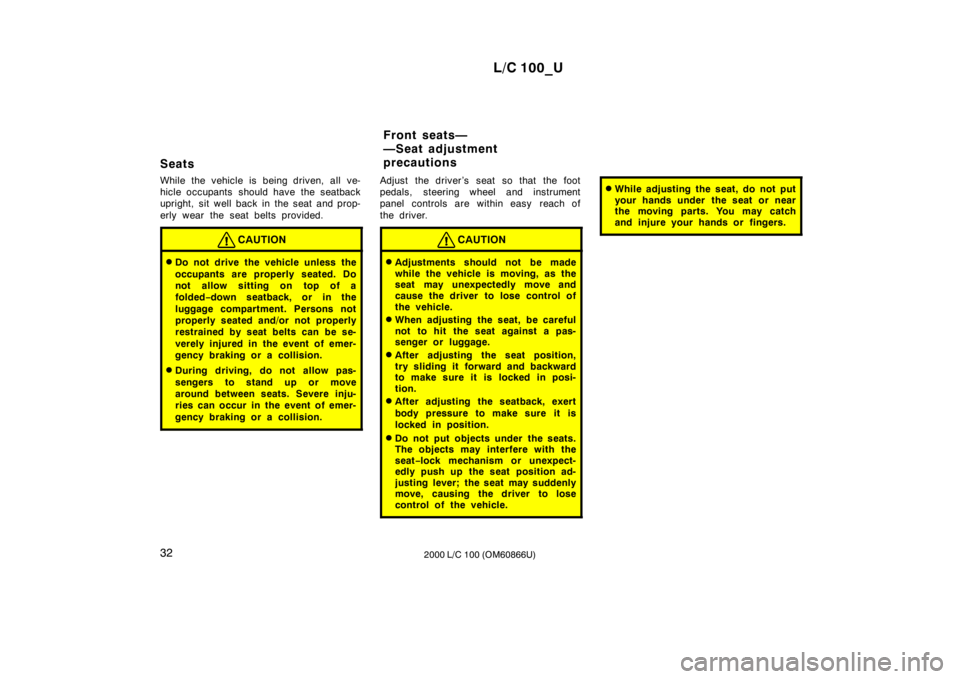
L/C 100_U
32 2000 L/C 100 (OM60866U)
Seats
While the vehicle is being driven, all ve-
hicle occupants should have the seatback
upright, sit well back in the seat and prop-
erly wear the seat belts provided.
CAUTION
�
Do not drive the vehicle unless the
occupants are properly seated. Do
not allow sitting on top of a
folded −down seatback, or in the
luggage compartment. Persons not
properly seated and/or not properly
restrained by seat belts can be se-
verely injured in the event of emer-
gency braking or a collision.
� During driving, do not allow pas-
sengers to stand up or move
around between seats. Severe inju-
ries can occur in the event of emer-
gency braking or a collision.
Adjust the driver’s seat so that the foot
pedals, steering wheel and instrument
panel controls are within easy reach of
the driver.
CAUTION
�Adjustments should not be made
while the vehicle is moving, as the
seat may unexpectedly move and
cause the driver to lose control of
the vehicle.
� When adjusting the seat, be careful
not to hit the seat against a pas-
senger or luggage.
� After adjusting the seat position,
try sliding it forward and backward
to make sure it is locked in posi-
tion.
� After adjusting the seatback, exert
body pressure to make sure it is
locked in position.
� Do not put objects under the seats.
The objects may interfere with the seat −lock mechanism or unexpect-
edly push up the seat position ad-
justing lever; the seat may suddenly
move, causing the driver to lose
control of the vehicle.
� While adjusting the seat, do not put
your hands under the seat or near
the moving parts. You may catch
and injure your hands or fingers.
Front seats—
—Seat adjustment
precautions
Page 32 of 235
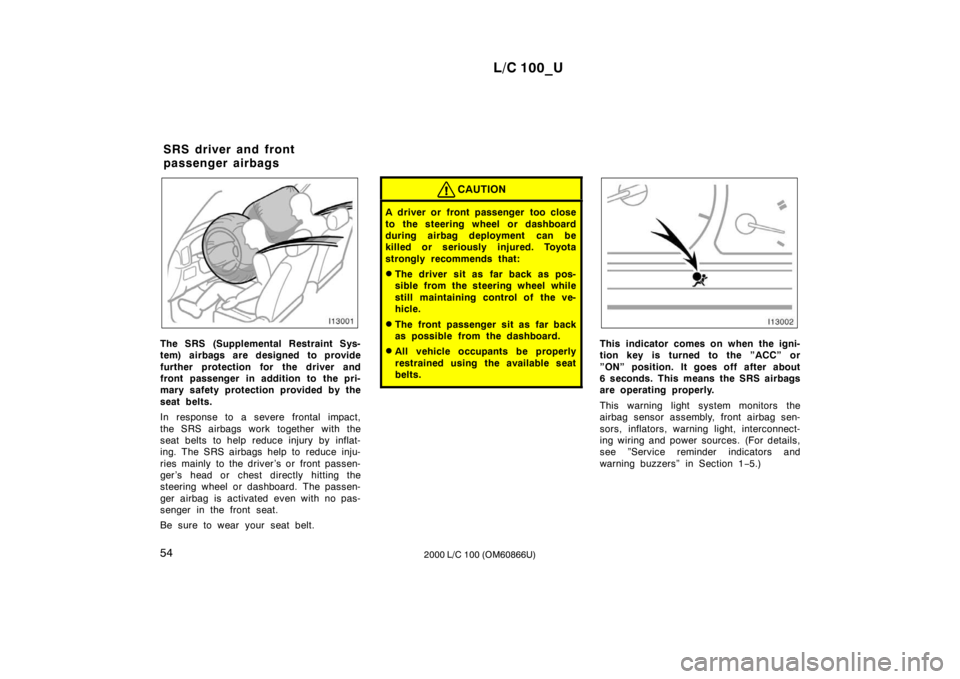
L/C 100_U
54 2000 L/C 100 (OM60866U)
The SRS (Supplemental Restraint Sys-
tem) airbags are designed to provide
further protection for the driver and
front passenger in addition to the pri-
mary safety protection provided by the
seat belts.
In response to a severe frontal impact,
the SRS airbags work together with the
seat belts to help reduce injury by inflat-
ing. The SRS airbags help to reduce inju-
ries mainly to the driver’s or front passen-
ger ’s head or chest directly hitting the
steering wheel or dashboard. The passen-
ger airbag is activated even with no pas-
senger in the front seat.
Be sure to wear your seat belt.
CAUTION
A driver or front passenger too close
to the steering wheel or dashboard
during airbag deployment can be
killed or seriously injured. Toyota
strongly recommends that: �The driver sit as far back as pos-
sible from the steering wheel while
still maintaining control of the ve-
hicle.
� The front passenger sit as far back
as possible from the dashboard.
� All vehicle occupants be properly
restrained using the available seat
belts.
This indicator comes on when the igni-
tion key is turned to the ”ACC” or
”ON” position. It goes off after about
6 seconds. This means the SRS airbags
are operating properly.
This warning light system monitors the
airbag sensor assembly, front airbag sen-
sors, inflators, warning light, interconnect-
ing wiring and power sources. (For details,
see ”Service reminder indicators and
warning buzzers” in Section 1 −5.)
SRS driver and front
passenger airbags
Page 34 of 235
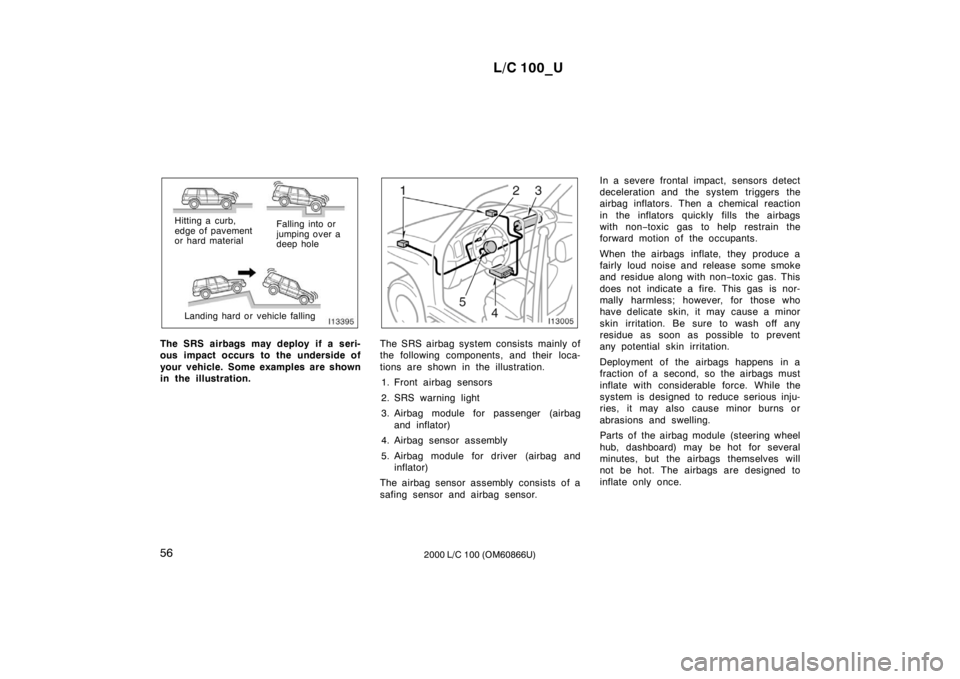
L/C 100_U
56 2000 L/C 100 (OM60866U)
Hitting a curb,
edge of pavement
or hard materialFalling into or
jumping over a
deep hole
Landing hard or vehicle falling
The SRS airbags may deploy if a seri-
ous impact occurs to the underside of
your vehicle. Some examples are shown
in the illustration.
The SRS airbag system consists mainly of
the following components, and their loca-
tions are shown in the illustration. 1. Front airbag sensors
2. SRS warning light
3. Airbag module for passenger (airbag and inflator)
4. Airbag sensor assembly
5. Airbag module for driver (airbag and inflator)
The airbag sensor assembly consists of a
safing sensor and airbag sensor. In a severe frontal impact, sensors detect
deceleration and the system triggers the
airbag inflators. Then a chemical reaction
in the inflators quickly fills the airbags
with non
−toxic gas to help restrain the
forward motion of the occupants.
When the airbags inflate, they produce a
fairly loud noise and release some smoke
and residue along with non −toxic gas. This
does not indicate a fire. This gas is nor-
mally harmless; however, for those who
have delicate skin, it may cause a minor
skin irritation. Be sure to wash off any
residue as soon as possible to prevent
any potential skin irritation.
Deployment of the airbags happens in a
fraction of a second, so the airbags must
inflate with considerable force. While the
system is desi gned to reduce serious inju-
ries, it may also cause minor burns or
abrasions and swelling.
Parts of the airbag module (steering wheel
hub, dashboard) may be hot for several
minutes, but the airbags themselves will
not be hot. The airbags are designed to
inflate only once.
Page 37 of 235
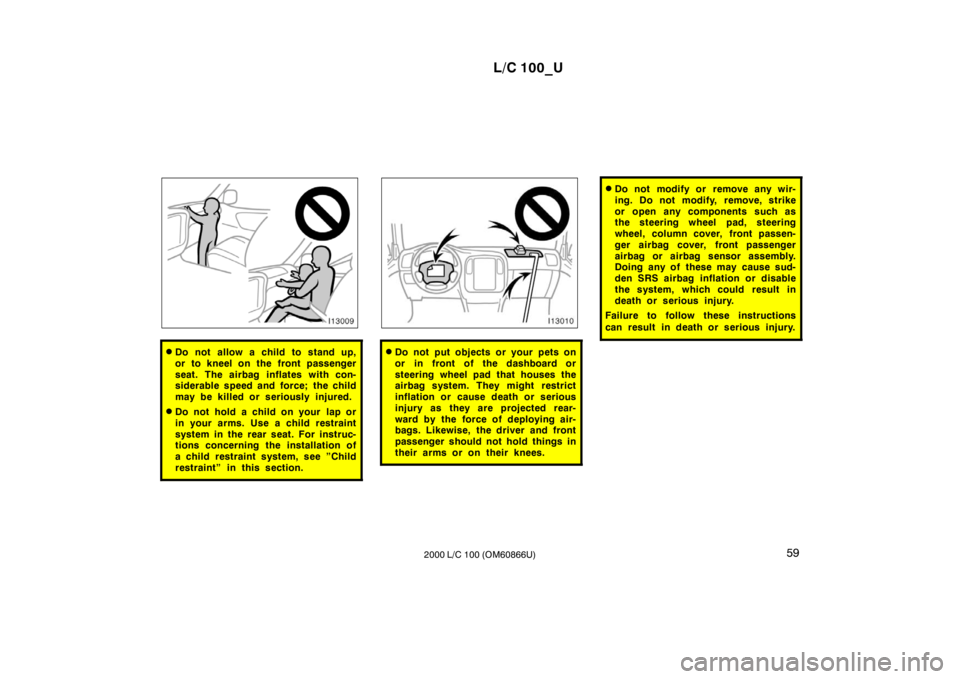
L/C 100_U59
2000 L/C 100 (OM60866U)
� Do not allow a child to stand up,
or to kneel on the front passenger
seat. The airbag inflates with con-
siderable speed and force; the child
may be killed or seriously injured.
� Do not hold a child on your lap or
in your arms. Use a child restraint
system in the rear seat. For instruc-
tions concerning the installation of
a child restraint system, see ”Child
restraint” in this section.�Do not put objects or your pets on
or in front of the dashboard or
steering wheel pad that houses the
airbag system. They might restrict
inflation or cause death or serious
injury as they are projected rear-
ward by the force of deploying air-
bags. Likewise, the driver and front
passenger should not hold things in
their arms or on their knees.
�Do not modify or remove any wir-
ing. Do not modify, remove, strike
or open any components such as
the steering wheel pad, steering
wheel, column cover, front passen-
ger airbag cover, front passenger
airbag or airbag sensor assembly.
Doing any of these may cause sud-
den SRS airbag inflation or disable
the system, which could result in
death or serious injury.
Failure to follow these instructions
can result in death or serious injury.
Page 38 of 235
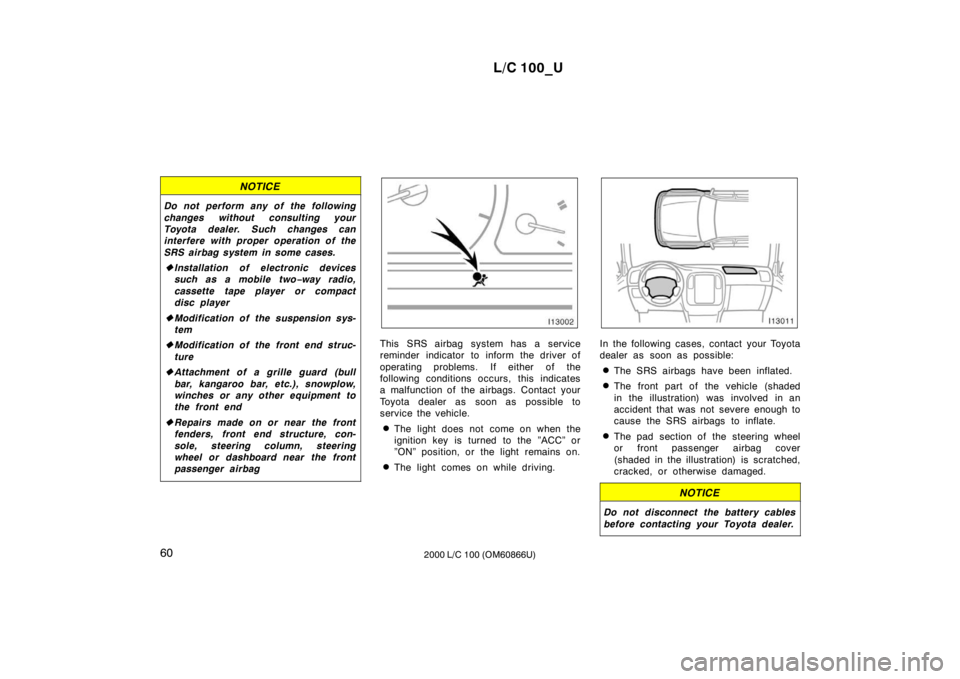
L/C 100_U
60 2000 L/C 100 (OM60866U)
NOTICE
Do not perform any of the following
changes without consulting your
Toyota dealer. Such changes can
interfere with proper operation of the
SRS airbag system in some cases. �Installation of electronic devices
such as a mobile two −way radio,
cassette tape player or compact
disc player
� Modification of the suspension sys-
tem
� Modification of the front end struc-
ture
� Attachment of a grille guard (bull
bar, kangaroo bar, etc.), snowplow,
winches or any other equipment to
the front end
� Repairs made on or near the front
fenders, front end structure, con-
sole, steering column, steering
wheel or dashboard near the front
passenger airbag
This SRS airbag system has a service
reminder indicator to inform the driver of
operating problems. If either of the
following conditions occurs, this indicates
a malfunction of the airbags. Contact your
Toyota dealer as soon as possible to
service the vehicle.
� The light does not come on when the
ignition key is turned to the ”ACC” or
”ON” position, or the light remains on.
� The light comes on while driving.In the following cases, contact your Toyota
dealer as soon as possible:
� The SRS airbags have been inflated.
� The front part of the vehicle (shaded
in the illustration) was involved in an
accident that was not severe enough to
cause the SRS airbags to inflate.
� The pad section of the steering wheel
or front passenger airbag cover
(shaded in the illustration) is scratched,
cracked, or otherwise damaged.
NOTICE
Do not disconnect the battery cables
before contacting your Toyota dealer.
Page 55 of 235
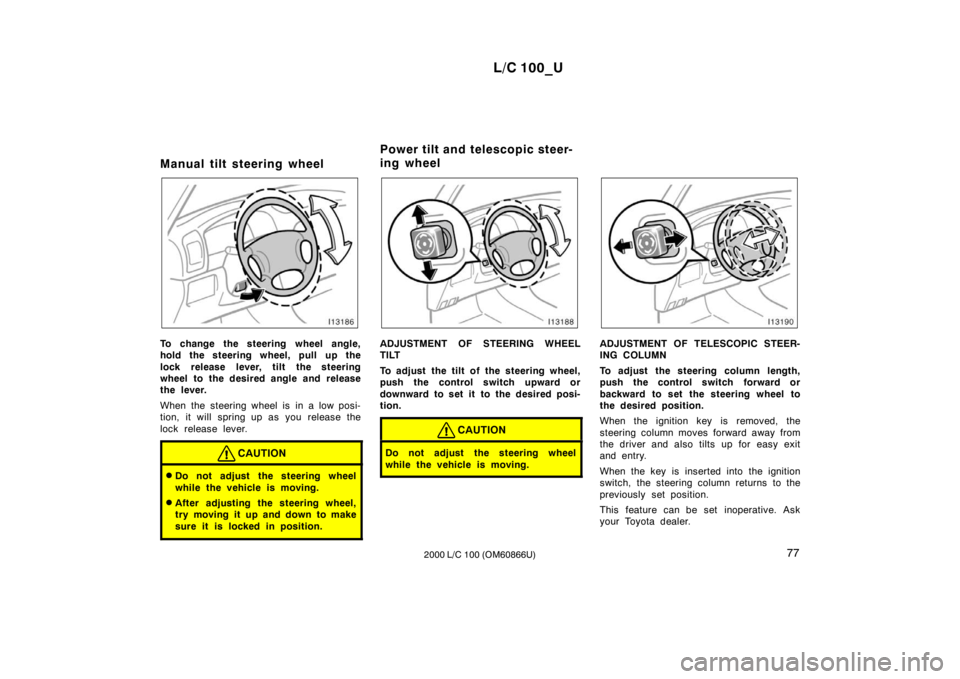
L/C 100_U77
2000 L/C 100 (OM60866U)
Manual tilt steering wheel
To change the steering wheel angle,
hold the steering wheel, pull up the
lock release lever, tilt the steering
wheel to the desired angle and release
the lever.
When the steering wheel is in a low posi-
tion, it will spring up as you release the
lock release lever.
CAUTION
�
Do not adjust the steering wheel
while the vehicle is moving.
� After adjusting the steering wheel,
try moving it up and down to make
sure it is locked in position.
ADJUSTMENT OF STEERING WHEEL
TILT
To adjust the tilt of the steering wheel,
push the control switch upward or
downward to set it to the desired posi-
tion.
CAUTION
Do not adjust the steering wheel
while the vehicle is moving.
ADJUSTMENT OF TELESCOPIC STEER-
ING COLUMN
To adjust the steering column length,
push the control switch forward or
backward to set the steering wheel to
the desired position.
When the ignition key is removed, the
steering column moves forward away from
the driver and also tilts up for easy exit
and entry.
When the key is inserted into the ignition
switch, the steering column returns to the
previously set position.
This feature can be set inoperative. Ask
your Toyota dealer.
Power tilt and telescopic steer-
ing wheel
Page 56 of 235
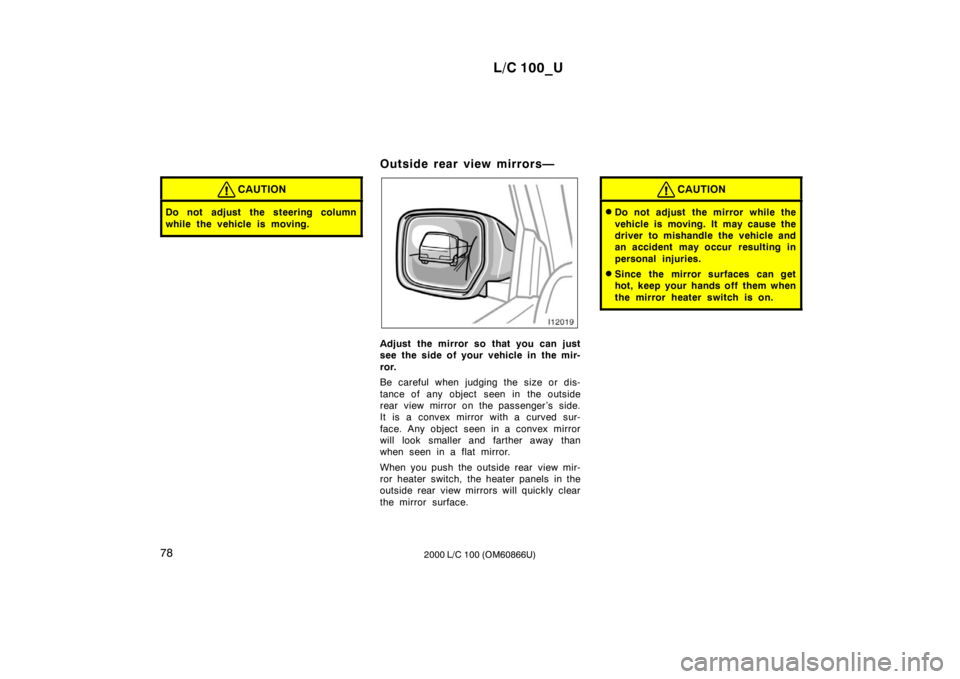
L/C 100_U
78 2000 L/C 100 (OM60866U)
CAUTION
Do not adjust the steering column
while the vehicle is moving.
Outside rear view mirrors—
Adjust the mirror so that you can just
see the side of your vehicle in the mir-
ror.
Be careful when judging the size or dis-
tance of any object seen in the outside
rear view mirror on the passenger ’s side.
It is a convex mirror with a curved sur-
face. Any object seen in a convex mirror
will look smaller and farther away than
when seen in a flat mirror.
When you push the outside rear view mir-
ror heater switch, the heater panels in the
outside rear view mirrors will quickly clear
the mirror surface.
CAUTION
�Do not adjust the mirror while the
vehicle is moving. It may cause the
driver to mishandle the vehicle and
an accident may occur resulting in
personal injuries.
� Since the mirror surfaces can get
hot, keep your hands off them when
the mirror heater switch is on.
Page 81 of 235

L/C 100_U103
2000 L/C 100 (OM60866U) OPERATION OF INSTRUMENTS AND
CONTROLS
Ignition switch, Transmission and Parking brake
Ignition switch with steering lock104
. . . . . . . . . . . . . . . . . . . . . . . . . . . . . .
Automatic transmission105
. . . . . . . . . . . . . . . . . . . . . . . . . . . . . . . . . . . . .
Four–wheel drive system 109
. . . . . . . . . . . . . . . . . . . . . . . . . . . . . . . . . . . .
Parking brake11 2
. . . . . . . . . . . . . . . . . . . . . . . . . . . . . . . . . . . . . . . . . . . . . .
Cruise control11 2
. . . . . . . . . . . . . . . . . . . . . . . . . . . . . . . . . . . . . . . . . . . . . .
Active traction control system11 5
. . . . . . . . . . . . . . . . . . . . . . . . . . . . . . . .
Vehicle skid control system11 7
. . . . . . . . . . . . . . . . . . . . . . . . . . . . . . . . . . SECTION
1− 6